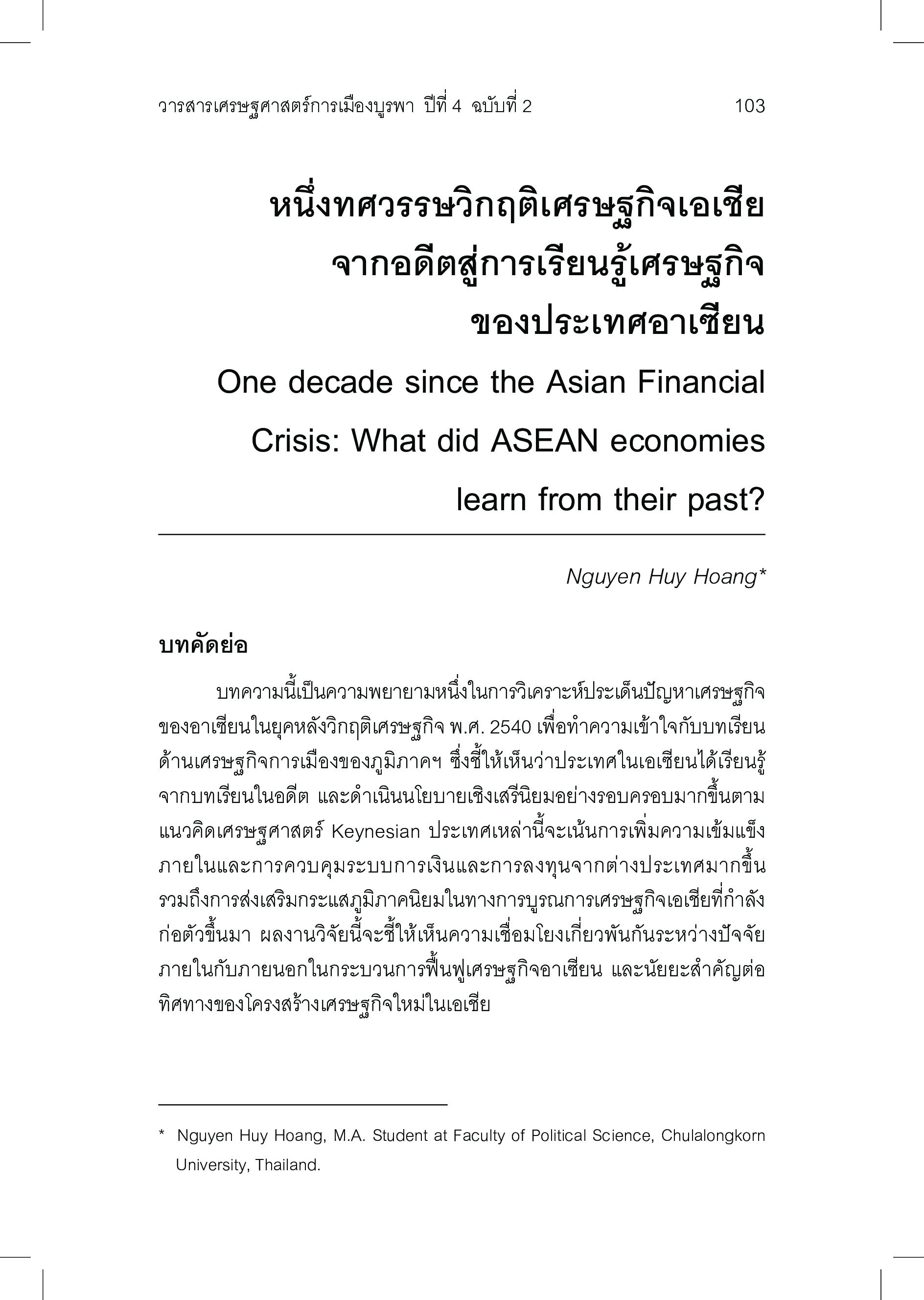หนึ่งทศวรรษวิกฤติเศรษฐกิจเอเชีย จากอดีตสู่การเรียนรู้เศรษฐกิจของประเทศอาเซียน
คำสำคัญ:
เอเชียตะวันออกเฉียงใต้, วิกฤติต้มยำกุ้ง, นโยบายเสรีนิยมใหม่, เศรษฐศาสตร์ Keynesian, การควบคุมเงินทุนบทคัดย่อ
บทความนี้เป็นความพยายามหนึ่งในการวิเคราะห์ประเด็นปัญหาเศรษฐกิจของอาเซียนในยุคหลังวิกฤติเศรษฐกิจ พ.ศ. 2540 เพื่อทำความเข้าใจกับบทเรียนด้านเศรษฐกิจการเมืองของภูมิภาคฯ ซึ่งชี้ให้เห็นว่าประเทศในเอเซียนได้เรียนรู้จากบทเรียนในอดีตและดำเนินนโยบายเชิงเสรีนิยมอย่างรอบครอบมากขึ้นตามแนวคิดเศรษฐศาสตร์ Keynesian ประเทศเหล่านี้จะเน้นการเพิ่มความเข้มแข็งภายในและการควบคุมระบบการเงินและการลงทุนจากต่างประเทศมากขึ้น รวมถึงการส่งเสริมกระแสภูมิภาคนิยมในทางการบูรณการเศรษฐกิจเอเชียที่กำลังก่อตัวขึ้นมา ผลงานวิจัยนี้จะชี้ให้เห็นความเชื่อมโยงเกี่ยวพันกันระหว่างปัจจัยภายในกับภายนอกในกระบวนการฟื้นฟูเศรษฐกิจอาเซียนและนัยยะสำคัญต่อทิศทางของโครงสร้างเศรษฐกิจใหม่ในเอเชีย
เอกสารอ้างอิง
Charette, D. E. (2006). "Malaysia in the Global Economy: Crisis, Recovery, and the Road Ahead,". In New England Journal of Public Policy, 21, Article 6.
Chirathiwat, S. (2011). Managing Economic Crisis in South East Asia. Singapore: ISAS Singapore.
Corsetti, G. P. P. & Roubini, N. (1998). What caused the Asian currency and financial crisis?. National Bureau of Economic Research.
Davis, R. F. (ed.). (2001). Financial Crises in “Successful” emerging economies. Virginia: Brookings.
Eichengreen, B. (1999). Toward a New International Financial Architecture: A Practical Post-Asia Agenda. Washington DC: Institute for International Economics.
Hardt, M. & Negri, A. (2000). Empire. Massachuset: Havard University Press.
Khatri, A. (2011). Hedge Funds and Asian crisis: A perspective of hot money and structural deficiencies. Delhi: Jindal Global Law School.
Korinek, A. (2010). Hot Money and Serial Financial Crises. In 11th Jacques Polak Annual Research Conference, November 4-5.
Manupipatpong, W. (n.d.). Regional initiatives for financial stability in ASEAN and East Asia. Retrieved January 5, 2016, from www.unescap.org/sites/default/files/Bulletin02-ch8.pdf.
Mishkin, F. (1999). “Lessons from the Asian Crisis.” In Journal of International Money and Finance, 18, pp. 709–723.
Montes, M. & Popov, V. (eds.). (2011). After math A new global economic order. New York: New York University Press.
Moschella, M. (2010). Governing risk: The IMF and global financial crises. New York: Palgrave.
Muchala, B. (ed.). (2007). Ten years after: Revisiting the Asian financial crisis. Washington: Woodrow Wilson International Center for Scholars.
Nijathaworn, B. (2012). Thailand: from financial crisis to financial resilience. In East Asia Forum.
Palley, T. I. (1999). Toward a new international economic order: Goodbye to Washington Consensus, Hello Washington Alternative. Retrieved January 5, 2016, from https://pdfs.semanticscholar.org/f498/10b6dd40ca8fba62c896e862e0281e16c32b.pdf.
Promfet, R. (2010). Regionalism in East Asia Why has it flourished since 2000. Singapore: World Scientific Publishing.
Putra, F. (2012). Economic Development and Crisis Policy Responses in Southeast Asia (Comparative study of Asian Crisis 1997 and Global Financial Crisis 2008 in Malaysia, Thailand and the Philippines). In International Conference on Economics Marketing and Management IPEDR Vol.28, Singapore.
Radelet, S. & Sachs, J. (1998). The East-Asian Financial Crisis: Diagnosis, Remedies, Prospects. In Brookings Papers on Economic Activity, 1 (1998), pp. 1-90.
Sharma, S. (2003). The Asian Financial Crisis: Crisis, reform and recovery. Manchester: Manchester University Press.
Stiglitz, J. (2003). Globalization and its Discontents. New York: Norton.
West, J. (n.d.). AMRO-the ASEAN+3 Macroeconomic Research Office. Retrieved January 5, 2016, from http://www.asiancenturyinstitute.com/economy/249-asian-economic-surveillance-and-amr o4.






